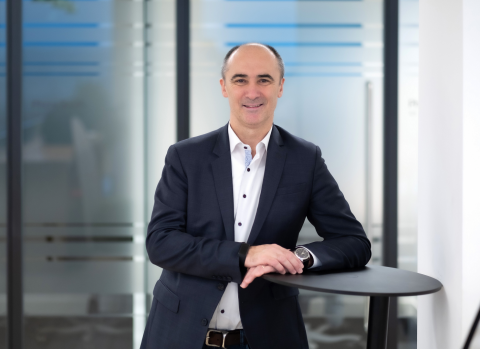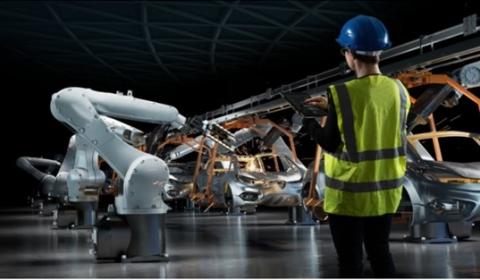In conversation with Franck Bouétard, CEO Ericsson France
17 February 2021
Ericsson is a European leader in the cellular and 5G technologies that are enabling the transformation of industry and the digital and green transition. As part of our ‘In conversation with’ series, we sat down with Franck Bouétard, CEO of Ericsson France, to get his views and insights on advanced manufacturing at the leading edge, the opportunities and the challenges, and how to build Europe’s global technology leadership.

Can you give us a brief overview of Ericsson, its size and leadership especially in the area of transforming industries?
Ericsson is an ICT and 5G leader present in more than 180 countries, with more than 99 000 employees worldwide. The company is also a strong European player investing €4 billion in R&D annually and employing almost 40,000 people in Europe. In this era of transforming industries, Ericsson has around 100 Industry 4.0 references and 5G for Industries, established since 2015. We are leading the industry to innovate at scale, being the first contributor in 5G through the Third Generation Partnership Project (3GPP) and also to the O-RAN Alliance for open innovation.
How do you define ‘advanced manufacturing’, what does it look like from where you’re sitting and where is it headed? Is it a differentiator for Europe?
Advanced manufacturing is well defined in the Industry 4.0 model, from the first step of transforming from analogic to digital processes, to connecting processes and, lastly, connecting the end customer’s device and process back to your own supply process. Cellular technology is the driving force, and is rapidly reshaping manufacturing. By 2030 there will be 4.7 billion wireless modules across smart manufacturing floors, with a value of over US$ 1 trillion. And it is this seamless connectivity that is ushering in a new era in manufacturing.
The objective for us with cellular technology & 5G in industrial environments is to enable manufacturers to conduct their operations more efficiently, deploying autonomous mobile robots, collaborative robots, digital twins, augmented reality and asset condition monitoring, resulting in tangible cost savings in facilities. By investing in the next generation of mobile connectivity, Europe will enable the comprehensive digitalisation of its industries and public services and unlock net economic benefits worth €165 billion.
5G is a must to ensure European competitiveness, achieving Europe’s Digital Decade and its economic recovery. It generates new use cases inside the plants but also in the manufacturing ecosystem at large, including transport & logistics. It allows advanced manufacturing and the management of huge amount of data. Europe has a huge potential prize but risks slipping behind and missing out. Our own estimates from a report we have commissioned with Qualcomm from Analysys Mason show that 5G can deliver €270bn of net economic benefits per year, corresponding to a 2% per annum GDP uplift. The return on investment would be seven-fold.
5G will be critical to winning the global race for growth… Europe has a huge potential prize but risks slipping behind and missing out.
Can you give us a real example of how what you do is transforming manufacturing?
We work with Mercedes-Benz in Germany and, thanks to Ericsson 5G networks, its production efficiency should increase by 15% by 2022 due to real time data management and the security of data. How? An optimal arrangement of Ericsson's 5G indoor antennas ensures uninterrupted mobile radio coverage over an area of approximately 20,000 square metres of the Mercedes Factory 56 in Sindelfingen, near Stuttgart. All data converge in the local core network on compact servers and are processed centrally there, so they remain the full property of the company. The 5G campus network ensures that machines and equipment on the factory floor communicate with each other intelligently, securely and in real-time.
All of that means that production lines can be designed extremely flexibly, depending on requirements and the production situation. Instead of manually rebuilding production for each car model, various production components are always flexibly interlinked. What’s more, this optimisation and flexibility has helped the company significantly reduce its energy requirements and achieve a zero-carbon factory.
What we implement for other industries, we also put in place in our own factories. For example, in our Ericsson plant in Tallinn, Estonia, we concluded that average fault detection time could be reduced by more than 15% thanks to augmented reality – we were able to visualise a mix of reality and data to provide instructions, increase understanding, safety and much more.
What are the main obstacles that you are coming up against? Technological, regulatory, political?
Europe includes a lot of countries, a lot of languages and a lot of operators.
There is a problem of scale. The Commission should be a facilitator of a common framework with a common EU policy and allow each country to advance at its own path. Europe should accelerate investments in innovation.

Many use cases in the Industry 4.0 model require that devices and processes are connected all the time to monitor where they are and how they perform. There is also a need for large amount of data to be collected and exchanged between processes, securely and reliably. And that means 5G. Thanks to its higher speeds, lower latency and greater capacity, 5G supports both the seamless sharing and processing of industrial data and the IoT infrastructure that increasingly underpins the collection of industrial data. 5G technology will also enable a whole new range of edge cloud computing applications, offering Europe the chance to build capacity and leadership in the next generation of cloud.
But to enable a fast transition, there needs to be specific and significant funding from innovation agencies. Further delays in rollout will slow down the adaptation to 4.0 digitalisation.
How can EU policy help to unblock those obstacles and support Europe's technology leadership and competitiveness, deliver greater ‘strategic autonomy’ as the EU calls it, and the digital and green transition?
Like all crises, the Covid-19 pandemic has accelerated existing trends for fast-forwarding digitalisation by several years. As industry digitalises, it is inevitable that many jobs will disappear due to massive efficiency gains and new ones will be created. So Europe needs a policy that facilitates new jobs creation in Europe so that those new jobs are not only created in North East Asia and North America but also here.
For a sense of the scale of this opportunity, think about platform companies created over the past decade like Facebook, Netflix, Alibaba and Tik Tok that all rely on 4G. Many of these companies were established in either USA or China, which were 2-3 years ahead of Europe in building out 4G networks. Europe has already fallen behind North East Asia and the US in the race for 5G connectivity. For example, China’s mobile base is now 11% 5G, the US is at 4%, compared to Europe at 1%. China is currently building out up to 15,000 5G antennas a week and South Korea already has near complete 5G coverage in the country. Their governments recognise the centrality of 5G to their long-term industrial strategies and economic success. The USA is currently running hard to catch up deploying 5G at high speed. So it is time to act. We need to speed up 5G deployment now!
We believe that digital technologies have the potential to reduce net global carbon emissions by up to 15% by 2030, representing a third of the 50% reduction targets set by the Paris Climate Accord.
Europe must also use the economic recovery to accelerate the green transition and invest in the decarbonisation of its economy. As the next generation in mobile connectivity, 5G has a key role to play in making Europe the world’s first climate-neutral continent. We believe that digital technologies have the potential to reduce net global carbon emissions by up to 15% by 2030, representing a third of the 50% reduction targets set by the Paris Climate Accord. The higher speeds, lower latency and greater capacity it provides will unlock countless applications key to creating a greener economy, from smart agriculture and manufacturing to smart cities and driverless cars, to smart power grids and more renewable energy.
Indeed, energy efficiency is another reason why I believe Europe should be pressing ahead with 5G rollouts today rather than diverting funds to experimental technologies such as Open RAN that will not mature in another few years. In our tests, our equipment offers energy and therefore related CO2 savings of up to 40% compared to what we believe is possible from piecing together a network system from a large number of vendors. Open RAN will surely have a role, but the market, and not government subsidies, should finance these technologies.
Of course, security is a key topic to address, too, and Europe has taken some very good initiatives with the 5G EU toolbox.
From a policy perspective, how divergent are the needs of a small business and a large organization such as Ericsson?
The needs of small business and large organisations like Ericsson are similar when it comes to employment flexibility. And, because ecosystem development plays a key role to support economic recovery, the European framework should both foster the development of start-ups and enable the emergence of European ICT champions. We don’t have European native GAFA, despite our great innovation and expertise. Let’s put in place the market conditions to enable the emergence of such ICT giants, able to play at worldwide scale.
Mr Bouétard also recently participated in Orgalim’s Industrial Strategy in Focus roundtable on Global Technology Leadership in Action in collaboration with EU Industry Week, which you can revisit here.
For an SME perspective on advanced manufacturing leadership, please read our previous ‘In conversation with’ Maurice Ditewig of Hellebrekers here.